
The
single prerequeset required for employment at any respectable
gaming magazine is a mental disability.
Here
you'll find some classic examples proving this unfortunately
little-known fact.
|
Wondering
what the hell "Blue
Shadows" means? Read all about it right here!
|
Air
Zonk
|
|
GamePro
Nov '92 Turbochip Pro Review
|
|
"Too
bad the super cool graphics aren't matched by super cool tunes."
|
|
|
| Anyone
who's actually played Air Zonk/PC Denjin will tell you that
the first thing that jumps out at you when you play the game is
the amazing music. It's a large, varied and well composed soundtrack.
It uses some of the least vanilla PCE/TG-16 PSG sounds and
takes them even further by using them in very creative ways to produce
some cool and unique effects. On top of all this, a large number
of samples are used to perfectly balance and complement the rest
of the music.
If
you aren't familiar with this game or haven't played it for awhile,
you can listen to the entire soundtrack here.
|
| Now
some would argue whether or not I should take too seriously anything
said by someone who goes by the handle of "Otter Matic".
|
|
|
| But
I would argue whether or not anyone calling themselves "Otter
Matic" should be employed at a professional video game
magazine in the first place. |
|
You
can read the entire "Pro Review" by clicking
the image below.
|
|
|
|
Loom
|
|
GamePro
Nov '92 Turbo Super CD Preview
|
|
"Gorgeous
3-D graphics and rich music weave a tapestry that unfolds artfully
as you explore Loom's landscape."
|
Anyone
who's actually played Loom knows what a dog of a game
it is. Instead of taking the time to properly port over the
256-color version of the PC game (however, I'm not
sure how nice the non-bg art in the original could've been),
they instead slapped the 16-color version onto a Duo CD,
with only the ocassional touch up.
The
limited ammount of CD music consists of butchered synth renditions
of Tchaikovsky’s Swan Lake.
And
they didn't even try to get a decent PSG sound or use
samples for the music weaving, instead it's literally as bad
as it can possibly sound on a Turbografx-16/PC Engine
system(not completely garbage, but it sure ain't gorgeous).
You
can listen to some of the rich music that you weave while playing
this gorgeous game right here.
The
first 5 sceenshots below are somewhat misleading. They were
captured through an emulator. When the game is played on real
TG-16/PCE hardware with regular composite video display,
it just turns into a complete ugly mess. Just as resourceful
programmers went crazy with dithering in later Genesis
games to use the hardware's display as a means to blend everything
together... somehow Loom takes the actual limited graphics
and uses the hardware to exponentially destroy the image.
Checkout
the last screenshot to see what "Pro Reviewer"
"Andromeda" would've been looking at.
|
|
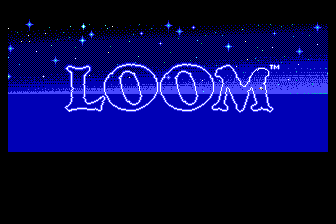 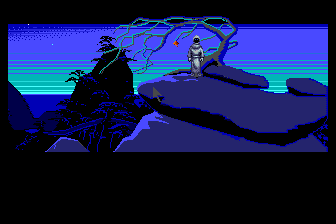
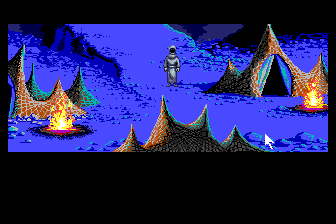 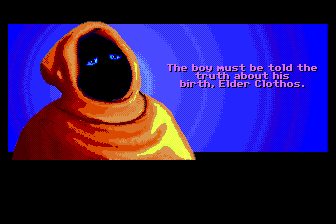
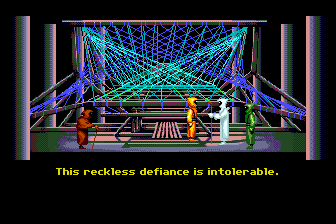 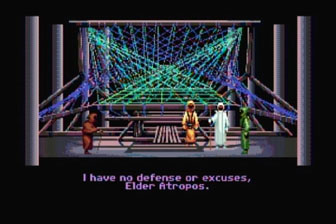
|
|
That
last screenshot above is probably the most gorgeous scene in the
game. Seriously.
But
notice the dialogue. Do you wonder if it's straight from the original,
or an in game admission by the developers of what an awful port
they've dumped on poor unsuspecting Turbo Fans?
|
|
You
can read the entire Preview by clicking the image below.
|
|
|
Now
a (perhaps) interesting side-note. As ironic as it is that a
few pages before one Pro Reviewer slams the music in
Air Zonk, another Pro Reviewer lauds the music
and overall aesthetics of Loom... it's made all the more
eerie by my True-Life Turbografx Confessional Story.
After
years of enjoying quality North American and Japanese CD-ROM2
games, I was desperate for more Super CD titles after
they finally launched the format on this continent. And since
I love questy RPG's so much, I decided to give Loom a shot.
After-all, it was a powerful Super CD game right?
So as much as I was eager to play Air Zonk, after some
lengthy decision making I finally decided to buy Loom
instead. Boy was that a mistake.
I
wasn't familiar with the original Swan Lake pieces, so
the music sounded really great to me. The one good thing that
I will always be able to say about Loom, is that it introduced
me to Tchaikovsky. Right away I could see that TTI
had tried to trick me and every other Turbo Fan who'd
supported them all along with that single deceptive screenshot
that they'd been peddling for this game for so long.
But
hey, a great game can overcome audio and visual deficiencies
with outstanding gameplay right? Well, unfortunately, the game
is so buggy that graphics sometimes load garbled, audio can
turn into nasty static, sounding like track 2 of most Duo
games in a regular CD player, it just plain crashed
every once in awhile... and a good number of Saves either didn't
take or later mysteriously disappeared.
And
after playing through the game on every difficulty several times,
as I did all Turbo games back in the day, I was left
with a bad feeling about the whole experience. So I did what
I had to. I went back to Radio Shack and asked if I could
exchange it as defective and take Air Zonk instead. Needless
to say, this allowed me to appreciate Air Zonk all the more.
As soon as I turned it on, I was blown away by the amazing music...
|
|
Street
Fighter II CE
|
|
GamePro
Sept '93 PC Engine Overseas Prospects
|
"The
graphics are strikingly colorful and detailed, especially by
PC Engine standards."
"While
the audio's not without some distorted PC Engine twings and
twangs, overall the sounds are surprisingly clear and accurate."
"SF
II CE is a resounding blow to critics of the PC Engine's technical
capabilities."
|
Okay,
that first quote refers to how the PC Engine's graphics
suck. The second quote again straight up explains how the PC
Engine's sound sucks. Now that third quote...
By "critics of the PC Engine's technical capabilities",
Pro Reviewer "Slasher Quan" must be refering
to himself and/or GamePro magazine
right?
Although
that much alone is enough to warrant spot in the prestigious
Blue Shadows hall of fame, let me further point out that
colorful graphics are what the PC Engine has always
been known for. The Genesis is known for independant
background scrolling, particularly ridiculous ammounts of parallax,
FM music and speed (they actually designed a mascot around
that last point). The Super Nintendo is known for transparencies,
Scaling & Rotation and it's unique sounding (some
would say "the best") sound chip.
Although
for the most part, the PC Engine is universally known
more for its content than any particular technical specialty
(before neo-console-wars-fanboyism spawned on the internet,
it was considered common knowledge that the PC Engine
was adept at throwing around tons of sprites of all sizes as
well as just plain doing a lot at once), the one exception
is colorful graphics. Even Turbo-haters still give it
at least that much. By 1993 there had been enough quality PC
Engine titles (also featuring quality sound samples) released
on both HuCard and CD that anyone familiar enough
with the system to judge it would know this.
|
|
You
can read the entire Overseas Prospects article by clicking
the image below.
|
|
|
|
Castlevania
Bloodlines
|
|
EGM
Feb '94 Sega Genesis Review
|
"I
admit it. Konami is the king of Castlevania games"
|
This
one's pretty self-explanitory, but since it's so unbelievable,
you can see the article for yourself right here.
|
|
Sherlock
Holmes 1 & 2
|
|
EGM
Turbografx-CD Reviews
|
"This
is the wave of the future!"
-first
line of the review of Sherlock Holmes 1 by Steve Harris: Publisher,
Editor-In-Chief EGM
"I
really hate these types of games - they bore me to tears, and
once you finish them, there is hardly any reason to play them
again!"
-first
line of the review of Sherlock Holmes 2 by Steve Harris: Publisher,
Editor-In-Chief EGM
|
Again,
another straight-forward example and this kind of professional
journalism which is the very reason Blue Shadows was
created.
If
you read the rest of the original Shelock Holmes reviews, you
can see how they rant and rave about fmv being the only way
to go, or "the wave of the future!" or "the
type of games we'll be playing two years from now. It is revolutionary,
challenging and years ahead of its time."
|
|
Click
on either image below to read the full reviews.
|
|
|
| Now
most people seem to blame Sega for the generation of fmv
games. You can't blame the "gamers", because they obviously
weren't buying it, otherwise the Sega-CD would've been a
resounding success. I think it's clear here that if anyone's to
blame for the flood of fmv games, it's all the professional
video game journalists who went crazy for them and literally told
publishers to go nuts and saturate the market with them. If you
take a look at the reviews of games like Sewer Shark and
Night Trap (we can both assume they'll show up here soon),
how can you blame game developers for pumping out garbage fmv
games when the all the professionals said it was gold? |
|
Whomp
'em
|
|
EGM
NES Review
|
"Whomp
'em is an(sic) interesting game. I liked the American Indian
idea, especially since most action games don't get creative
to try new themes."
-Sushi-X,
Assistant Editor EGM
|
Yes,
Whomp 'em is exactly what it sounds like. You can check
out the entire review right here.
Make sure to read the entire game description at the
top , all the way through to "How!"
|
|
Midnight
Resistance & NHL Hockey
|
|
EGM
Sega Genesis Reviews
|
"Midnight
Resistance is awesome!!!"
-first
line of the review by Sushi-X, Assistant Editor EGM
"NHL
Hockey is awesome!"
-first
line of the review by Sushi-X, Assistant Editor EGM
|
Surprisingly,
Sushi-X gave both games an 8, even though
Midnight Resistance got 2 more exclamation marks
after its "awesome". Both reviews just happened to
appear next to each other (due to the alphabetical listing)
in EGM's annual Buyer's Guide.
|
|
Ground
Zero, Texas
|
|
EGM
Feb '94 Sega-CD Review
|
"This
has got to be the best Sega CD game I have ever played."
"Overall
this is the best Sega CD game you can probably consider."
-Ed
Semrad, Associate Publisher EGM
|
By
this point in the Sega-CD's lifespan, the following games
had already been released: Dark Wizard, Ecco The Dolphin
CD, Chuck Rock, Chuck Rock II, Dune, Final Fight CD, Hook, Keio
Flying Squadron, LUNAR: The Silver Star, Prince Of Persia, Robo
Aleste, Samurai Showdown, Silpheed, Sonic CD, Sol-Feace, The
Terminator, and Wolfchild.
Much
of this list was made going by dates found online, so some of
these titles may have actually been released later on in 1994,
after Ground Zero, Texas was reviewed. But it doesn't
take an Associate Publisher at a major gaming magazine
to figure out how many quality (non-fmv) Sega-CD titles
were released well before Ground Zero, Texas.
Incidently,
when video game sales/rental chain Microplay went out
of business, the local store here carried on and eventually
changed their name to Ground Zero. There's even an old
musty copy of the game sitting on a shelf in the back of the
store. Perhaps the game had another fan as big as Ed Semrad.
|
|
You
can read the entire Review by clicking the image below.
|
|
|
|
Panzer
Dragoon II Zwei
|
|
Gamefan
Volume 4 Issue 5, Sega Saturn Review
|
"PD
Eine, which ostensibly takes place many years after PD
Zwei, (Speaking of that, why does every other mag call this
game Panzer Dragoon II Zwei? That's like saying Street
Fighter II Two or something...) was but a small chapter
in the Panzer Dragoon saga..."
-Nick
Rox, Layout/Editor Gamefan
|
I
think most people reading this would realize the answer to Nick
Rox's question. In fact, it's right there literally two
millimetres away from that very same quote. The official Panzer
Dragoon II Zwei logo, as it appears on the cover of every
version of the game, clearly says "Panzer Dragoon II
Zwei". If Nick Rox has a problem with this,
he should blame Sega, not "everything other mag".
As
for Street Fighter II, that's it's real actual title,
"Street Fighter II". If Capcom had put
it out as "Street Fighter II Deux", then
he'd be talking about the same thing, but would still be wrong.
It'd still really be titled Street Fighter II Deux.
But if every other mag started calling Street Fighter
II, "Street Fighter Deux",
then they'd all be the ones making shit up.
But
here's the thing, it's actually Nick Rox who insists
on calling the original Panzer Dragoon game "PD
Eine". But that's not what it's called. It's always
just been Panzer Dragoon. Just because a later sequal
to a game uses a word or symbol in it's title, it doesn't automatically
rename every other game in the series.
Calling
the first Panzer Dragoon game "PD Eine"
or "Panzer Eine" is like calling the original
Street Fighter game "Street Fighter Alpha"
just because Street Fighter II was released. Or by the
same logic, after the real Street Fighter Alpha game
was released in North America, I guess we should all refer to
the original Street Fighter game as "Street Fighter
Zero" right?
And
I guess then that the real name of Panzer Dragoon Saga/Azel
must be Panzer Dragoon III Drei?
Remember,
it was Nick Rox who started calling everyone on this
while within the same sentence was the first and only one to
really be guilty of what he was suggesting.
But
in the end, the real point Nick Rox was trying
to make, is that he can count to two in German.
|
|
You
can read the entire Review by clicking the image below.
|
|
|
|
Panzer
Dragoon II Zwei
|
|
Gamefan
Volume 4 Issue 5, Sega Saturn Review
|
"Panzer
still suffers from grainy false transparencies, but this
problem is, sadly, unavoidable on the Saturn"
-Nick
Rox, Layout/Editor Gamefan
|
Here
we go again. First of all, we all now know that the Saturn
can do transparencies and everything else it wasn't designed
to do out-of-the-box through decent programming(look at Panzer
Dragoon Saga's multiple colored light sourcing with gourad
shading and 3D morphing). But even at that point in the
Saturn's life cycle, there were lots of games, like
Astal which Dave Halverson still goes on about
to this day, which featured true transparencies*.
But
even if Nick Rox was oblivious to all the transparency effects
used in Saturn games up to the release of Panzer Dragoon
II Zwei, the thing is, PDIIZ is one of the Saturn
games which features some amazing transparencies. There are
even screenshots in the same Gamefan review which show
the water transparency effect, with solid 3D objects jumping
in and out of it.
It's
true that the game also had mesh substitutes for the other transparencies,
but that doesn't change the fact that the "unavoidable
on Saturn" comment is ridiculous given the game being
reviewed and that there still was never any mention of all PDZII's
"true" transparencies in the article.
|
|
Once
again, you can read the entire Review by clicking the image
below.
|
|
|
e-mail
superpcenginegrafx.com
|

